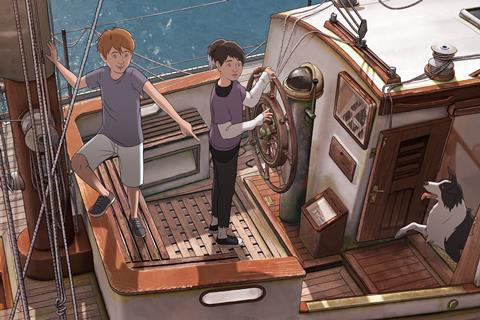
Kensuke’s Kingdom, the feature adaptation of Michael Morpurgo’s 1999 novel, premieres this week at Annecy International Animation Film Festival. The story takes place predominantly on a deserted island and features two characters with no shared language.
“It’s something audiences are used to with animation, particularly hand-drawn,” says producer Ruth Fielding of the limited dialogue. “If you think back to The Snowman [a 1982 animated TV film], nobody questions why there aren’t any words in it. Rather than a challenge, it’s an advantage for us because it makes the international sales that much easier – there’s not much dubbing to be done.”
Fielding runs UK-based Lupus Films with Camilla Deakin. They joined producers Sarah Radclyffe and Barnaby Spurrier on Kensuke’s Kingdom in 2016, after Radclyffe had tried to put together a live-action version of the novel.
When it became apparent “putting a young boy on a desert island with real orangutans was not terribly practical, possibly even dangerous”, as Deakin puts it, Radclyffe attached animation directors Neil Boyle and Kirk Hendry. Boyle’s credits as an animator include Who Framed Roger Rabbit? and Space Jam; while Hendry’s short Junk was Bifa-nominated in 2011.

Boyle then took the script by Frank Cottrell Boyce to Lupus, having worked with Deakin and Fielding on 2016 animation Ethel & Ernest. The duo were quickly persuaded. ‘Michael Morpurgo? Sarah Radclyffe? Frank Cottrell Boyce?’ – yes, of course we would.” recalls Fielding.
To raise the funding for a hand-drawn animation, Lupus returned to Melusine Productions, the Luxembourg firm with which it had collaborated on Ethel & Ernest, which has credits including co-producing Oscar-nominated Song Of The Sea, The Breadwinner and Wolfwalkers.
The production took a similar structure to Ethel & Ernest: pre-production and animation originated in the UK, backgrounds and animation happened in Luxembourg, and compositing, VFX and colouring took place in Wales through Bumpybox. This allowed Kensuke’s Kingdom to access Ffilm Cymru Wales funding. It also received over £1.8m funding from the BFI, from the development, pre-production and production funds, with its £1.6m production award the largest of its kind in 2020; €1.8m from Film Fund Luxembourg; and support from Creative Wales. A further £4.7m from Adrian Politowski’s Los Angeles-based production and finance company Align in April 2021 brought the total budget to the £9m range; Bankside Films is handling international sales.
Inclusive techniques
Animation started in March 2020, just as the pandemic was about to shut down the industry. “We had a bit of a nightmare, like ‘Oh god, how are we going to do it?’” says Deakin. But once the 80-strong production crew had become accustomed to technologies such as SyncSketch and Miro Board, “it worked in our favour.”
“The second lockdown at the end of 2020 meant we knew we had to set up as a working-from-home production,” she explains. “What that meant was the Luxembourg crew and the Cardiff crew weren’t disadvantaged. Everyone was working in the same way.”
The heads of departments conducted dailies calls with their team. “The animators found it helpful – they could see what other people were doing and what notes they were getting, whereas previously it had been more targeted individually,” says Deakin.
“They’re techniques we’ve carried on with into live production; it just feels more inclusive,” added Fielding.
According to the producers, Morpugo has been an enthusiastic and supportive presence. During the pandemic production phase, the author would meet up with Spurrier – a neighbour of Morpurgo’s – and watch early footage on Spurrier’s iPad from an acceptable distance.
“He was involved all the way along,” says Fielding. “He’d come up to London at different stages through the process and just enthuse about the work-in-progress. This for him is a massive calling card for his message that we must respect nature.”
“We’re not able to converse with orangutans, but we must learn to understand and appreciate them,” adds Deakin. “Michael feels really strongly about nature conservation and climate change – a really important message from the film is that we must respect and protect nature.”
The English-language voice cast includes Cillian Murphy and Sally Hawkins. Having worked with him on Godzilla, Hawkins then assisted in getting Japanese actor Ken Watanabe on board to voice Kensuke. Watanabe made tweaks to the script, with the production employing Ken Ochiai as a Japanese consultant to consider cultural references.
The film has been made in the cinemascope aspect ratio; with its rolling seas and island vistas, it marks a change for Lupus from the intimate household drama of Ethel & Ernest. “You have big, wide shots with characters as a tiny drop in the distance,” says Deakin.
The duo are already working on their next feature – Paloma Baeza’s Las Dos Fridas, exploring the life and legacy of Mexican artist Frida Kahlo. WestEnd Films has now boarded sales on the title, which is in development. No cast are attached yet, but there are “lots of exciting ideas flying around,” says Deakin.
After the Annecy premiere, Bankside is screening the film to international buyers at the three-day London Screenings event for buyers at Picturehouse Central from June 19-21.

























No comments yet